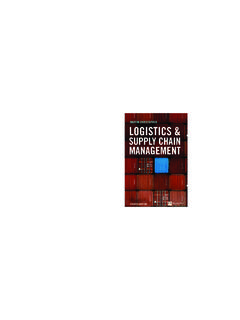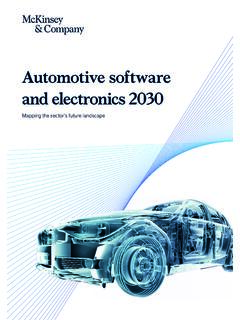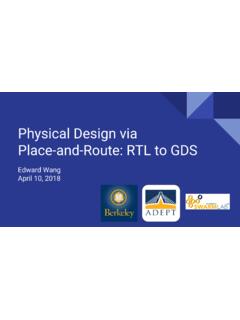Transcription of Economic Globalization: The Five Basic Globalization Types
1 Economic Globalization : The Five Basic Globalization Types Bruno G. Ruettimann Current Economic theory gives no sufficient practical models to explain the re- cent Economic development with respect to Globalization . In fact, the Economic Globalization is not always the same Globalization , which is recognized through the different manifestations of this phenomenon. Based on the four Basic busi- ness typologies (commodities, standards, specialties, and convenience goods). a new model defines five fundamental Types of Economic Globalization (1a, 1b, 1c, 2, and 3).
2 Globalization Type 1 and subtypes are related to physical material interchange, Type 2 is related to financial participations and Type 3 to the hu- man factor. This distinction is necessary because each type has its own rational and performs differently from a Globalization viewpoint. These Basic globaliza- tion Types help to model the triggering mechanism of their evolution and allow us to understand the competitive constellation and strategic moves of companies as well as the different latent potential for unemployment.
3 The Basic Globalization Types distinguished by the author allows a vivid explanation of the characteris- tics of Economic Globalization when teaching. Keywords: business Types , Globalization Types , foreign trade theory. Introduction On the one hand, Economic Globalization is often viewed as an obscure process that appar- ently yields more profit for the companies, while increasing unemployment for the work- ing classes. On the other hand, Globalization is hardly controllable, since it is not only a process but rather a phenotypical manifestation within the causal systemic world of econ- omy and politico-social behavior.
4 But how can Economic Globalization be modelled? Many books have been written on Globalization but none of them presents its integral the- ory. Basic concepts still go mainly back to foreign trade theory with Ricardian compara- tive cost advantages and Pareto optimality as well as Heckscher-Ohlin. The gravity model of Isard shows the geographic view on trade but finally did not encounter the merited suc- cess. A new view has been developed by Krugman in his New Economic Geography. Dif- ferent business and Globalization patterns are observable in different industries.
5 On the one hand, we have the extraction of raw materials in particular geographic regions of the sub- tropics, or primary aluminium production in distant but low energy cost regions, and, on the other hand, semi-fabricated products manufactured near extensively industrialized re- gions. Cars produced in highly automated factories in urban area and exported worldwide, fast-food chains or franchised fashion stores covering the globe to conquest market share . different concepts, but the same target: the world market.
6 Why do so many different con- Globalistics and Globalization Studies 2014 300 312. Ruettimann Economic Globalization 301. cepts exist? What are the rules governing the Economic structure and the competitive sys- tem? Is it possible to give a structure to Globalization in order to be modelled? The Determinants for Globalization Type Going beyond the usual phenomenological description of Globalization , let us analyze the intrinsic logic of worldwide competition and the structure of the Economic system. Our business system is mainly composed of: the transaction object, that is, a product or a service.
7 The supply and demand structure, with the related transaction scheme;. the operating configuration of supply (R ttimann 2007). The product is characterized by its attributes, for example, heavy or bulky, complex or precious, perishable or durable, and its customization degree, all these determining the transportability of the product. The transaction scheme describes how supply and demand interact determining the localization degree of the product. The market structures given by the number of market actors and relative concentration curves of supply and demand de- termine the competitive nature of the business.
8 The operating configuration refers to how products are produced, at one extreme they are produced centrally within a single plant configuration and then distributed worldwide, or production facilities are spread around different geographic regions within a multi-plant configuration and products are sold lo- cally. This leads to the induction scheme of Fig. 1 to classify first the business type and finally the Globalization type. Indeed, as we will see, Globalization is not always the same. Fig. 1. Framework of Globalization Types determinants Product Product Market Market characteristics characteristics structure structure Business Business Operating Operating classification classification configuration configuration Typeof Type ofglobalization Globalization As we can see in Fig.
9 1, it is evident that the typology of Globalization is largely deter- mined by the product characteristics. The backward determinants which influence product characteristics, market structure and determine the business classification, and finally the operating configuration, are: value of the product;. transport cost and related range of distribution;. production factors in terms of cost drivers;. demand profile;. supply structure (R ttimann 2007). 302 Globalistics and Globalization Studies The Four Basic Business Typologies These main determinants characterize each business type within industrial system.
10 Certain combinations of these determinants reveal clear patterns for each business type. Fig. 2. shows different businesses within the matrix of product-characteristics and market- structure which are the main drivers for business type classification (R ttimann 2007). The representation of product-characteristics (differentiated or not) as one axis, and market- structure (oligopolistic or fragmented) as another axis within a matrix, leads finally to the following landscape of Basic business Types : commodities.






